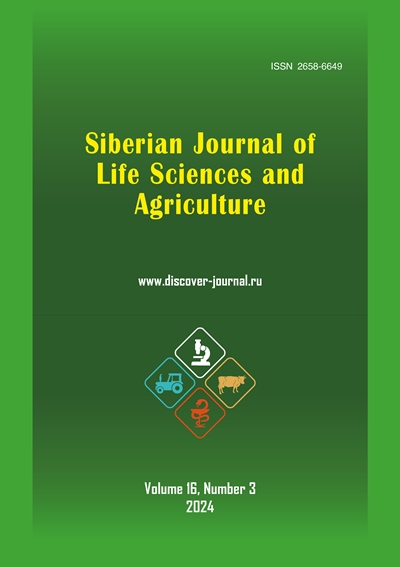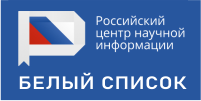ВАРИАТИВНОСТЬ ФЛУКТУИРУЮЩЕЙ АСИММЕТРИИ ЛИСТЬЕВ BETULA PENDULA ROTH В ЗАВИСИМОСТИ ОТ УСЛОВИЙ ПРОИЗРАСТАНИЯ
Аннотация
В работе определяли взаимосвязь (ФА) листьев березы повислой Betula pendula Roth с загрязнением атмосферы, климатическими показателями и характеристиками почвы. Анализировали данные, полученные с 10 участков, расположенных по основным географическим направлениям от г. Ухта (республика Коми, Россия). ФА вычисляли по 5 морфологическим параметрам (n=100). В почве определяли рН (водная и солевая вытяжки), содержание органического вещества и подвижных форм металлов. Данные по загрязнению воздушной среды и климатическим параметрам получали из открытых источников. Установлены высокие ФА B. pendula на всех участках (0,064-0,076). Было показано, что это не связано географическим положением района произрастания березы. На участках не выявлено превышения нормативов загрязняющих веществ в воздушной среде и почве. Корреляционный анализ показал, что ФА увеличивается в ответ на снижение доли органического вещества в почве и повышение кислотности почвы (r равен -0,49 и -0,42 соответственно). Также увеличение ФА связано с содержанием подвижных форм Pb, Mn, Cu (r равен 0,6, 0,36, 0,35 соответственно). Влияния содержания в почве подвижных Zn, Fe, Cd на уровень ФА листьев не выявлено. Таким образом, показано, что почвенные характеристики влияют на асимметрию растения-биоиндикатора, в том числе в пределах природоохранных нормативов. Этот факт необходимо учитывать при интерпретации результатов оценки экологического состояния территорий.
Скачивания
Литература
Список литературы
Методические рекомендации по выполнению оценки качества среды по состоянию живых существ (оценка стабильности развития живых организмов по уровню асимметрии морфологических структур). Распоряжение МПР № 460-р от 16.10.2003. М.: МПР, 2003. 24 с.
Стрельцов А. Б. Региональная система биологического мониторинга. Калуга: Изд-во Калужского ЦНТИ, 2003. 431 с.
Методические указания по определению тяжелых металлов в почвах сельхозугодий и продукции растениеводства. М.: ЦИНАО, 1992. 61 с.
Тюрин И. В. Органическое вещество почвы и его роль в плодородии. Москва: Наука, 1965. 320 с.
Предельно допустимые концентрации (ПДК) химических веществ в почве: Гигиенические нормативы. М.: Федеральный центр гигиены и эпиде-миологии Роспотребнадзора, 2006. 15 с.
Государственный доклад «О состоянии окружающей среды Республики Коми в 2022 году». Сыктывкар: Минприроды Республики Коми, 2023. 164 с.
Barišić Klisarić N., Miljković D., Avramov S., Živković U., Tarasjev A. Radial and bilateral fluctuating asymmetry of Iris pumila flowers as indicators of environmental stress // Symmetry. 2019. № 11(6). P. 818. https://doi.org/10.3390/sym11060818
Dalcorso G., Fasani E., Manara A., Visioli G., Furini A. Heavy metal pollutions: state of the art and innovation in phytoremediation // International journal of molecular sciences. 2019. Vol. 20(14), 3412. https://doi.org/ 10.3390/ijms20143412
Gubasheva B. E., Idrissova G. Z., Tumenov A. N. Rudn journal of ecology and life safety // RUDN journal of ecology and life safety. 2022. Vol. 30(3). P. 417-427. https://doi.org/10.22363/2313-2310-2022-30-3-417-427
Kabata-Pendias A. Trace Elements in Soils and Plant. 4th Edition, CRC Press, Boca Raton. 2010. 548 p. https://doi.org/10.1201/b10158
Karande U. B., Kadam A., Umrikar B. N., Wagh V., Sankhua R. N., & Pawar N. J. Environmental modelling of soil quality, heavy-metal enrichment and human health risk in sub-urbanized semiarid watershed of western India // Modeling Earth Systems and Environment. 2020. № 6. P. 545-556.
Mendes G., Boaventura M. G., Cornelissen T. (2018). Fluctuating asym-metry as a bioindicator of environmental stress caused by pollution in a pioneer plant species // Environmental entomology. 2018. Vol. 47(6). P. 1479-1484. https://doi.org/10.1093/ee/nvy147
Opekunova M. G., Opekunov A. Y., Kukushkin S. Y., & Ganul A. G. Background contents of heavy metals in soils and bottom sediments in the north of Western Siberia // Eurasian Soil Science. 2019. № 52. P. 380-395.
Palmer A. R. Fluctuating asymmetry analyses: A primer. In: Markow T.A. Ed., Developmental Instability: Its Origins and Evolutionary Implications, Kluwer Academic Publishers, Dordrecht, 1994. P. 335-364. https://doi.org/10.1007/978-94-011-0830-0_26
Piper C. S. Soil and plant analysis. Scientific Publishers, 2019.
Prihod’ko S. A., Shtirc Y. A. Primenenie morfogeometricheskogo metoda dlya opredeleniya pokazatelej fluktuiruyushchej asimmetrii listovoj plastinki Aser pseudoplatanus L. (Application of the morphometric method for determining the indicators of fluctuating asymmetry leaf plate Acer pseudoplatanus L.) // Ukrainian Journal of Ecology. 2018. № 8. P. 194-210. https://doi.org/10.15421/2018_204
Shadrina E., Turmukhametova N., Soldatova V., Vol’pert Y., Korotchenko I., & Pervyshina G. Fluctuating asymmetry in morphological characteristics of Betula pendula Roth leaf under conditions of urban ecosystems: evaluation of the multi-factor negative impact // Symmetry. 2020. Vol. 12(8), 1317. https://doi.org/10.3390/sym12081317
Shadrina E. G., Vol'pert Y. L. Bioindication Assessment of Environmental Quality in Vicinity of Underground Nuclear Explosion Sites on the Territory of the West Yakutia Using the Level of Fluctuating Asymmetry in Plants and Animals // Journal of Fundamental and Applied Sciences. 2018. Vol. 10(6S). P. 2950-2961. https://doi.org/10.4314/jfas.v10i6s.223
Turmukhametova N. V., Shadrina E. G., Soldatova V. Y., & Ivantsova E. N. Fluctuating asymmetry of the lamina of Betula pendula Roth in the context of different cities and industrial load // IOP Conference Series: Earth and Environmen-tal Science. 2021. Vol. 839(5), 052011. https://doi.org/10.1088/1755-1315/839/5/052011
Zhelev Z. M., Tsonev S. V., Angelov M. V. Fluctuating asymmetry in Pelophylax ridibundus meristic morphological traits and their importance in as-sessing environmental health // Ecological Indicators. 2019. Vol. 107, 105589. https://doi.org/10.1016/j.ecolind.2019.105589
References
Metodicheskiye rekomendatsii po vypolneniyu otsenki kachestva sredy po sostoyaniyu zhivykh sushchestv (otsenka stabil'nosti razvitiya zhivykh organizmov po urovnyu asimmetrii morfologicheskikh struktur) [Methodological recommendations for assessing the quality of the environment based on the state of living beings (assessing the stability of the development of living organisms based on the level of asymmetry of morphological structures)]. Order of the Ministry of Natural Resources№ 460-r, 16.10.2003. М.: MNR, 2003, 24 p.
Streltsov A. B. Regional'naya sistema biologicheskogo monitoringa [Re-gional biological monitoring system]. Kaluga: Publishing house of the Kaluga CSTI, 2003, 431 p.
Metodicheskiye ukazaniya po opredeleniyu tyazhelykh metallov v pochvakh sel'khozugodiy i produktsii rasteniyevodstva [Guidelines for the determination of heavy metals in soils of farmland and crop products]. М.: CIAS, 1992, 61 p.
Tyurin I. V. Organicheskoye veshchestvo pochvy i yego rol' v plodorodii [Soil organic matter and its role in fertility]. Moscow: Science, 1965, 320 p.
Predelno dopustimye kontsentratsii (PDK) khimicheskikh veshchestv v pochve: Gigienicheskie normativy [Maximum permissible concentrations (MAC) of chemicals in soil: Hygienic standards]. M.: Federal Center for Hygiene and Epidemi-ology of Rospotrebnadzor, 2006, 15 p.
Gosudarstvennyy doklad «O sostoyanii okruzhayushchey sredy Respubliki Komi v 2022 godu» [State report “On the state of the environment of the Komi Republic in 2022”]. Syktyvkar: Ministry of Natural Resources of the Komi Republic, 2023, 164 p.
Barišić Klisarić N., Miljković D., Avramov S., Živković U., Tarasjev A. Radial and bilateral fluctuating asymmetry of Iris pumila flowers as indicators of en-vironmental stress. Symmetry, 2019, vol. 11(6), 818. https://doi.org/10.3390/sym11060818
DalCorso G., Fasani E., Manara A., Visioli G., & Furini A. Heavy metal pollutions: state of the art and innovation in phytoremediation. International jour-nal of molecular sciences, 2019, vol. 20(14), 3412. https://doi.org/10.3390/ijms20143412
Gubasheva B. E., Idrissova G. Z., Tumenov A. N. Rudn journal of ecology and life safety. RUDN journal of ecology and life safety, 2022, vol. 30(3), pp. 417–427. https://doi.org/10.22363/2313-2310-2022-30-3-417-427
Kabata-Pendias A. Trace Elements in Soils and Plant. 4th Edition, CRC Press, Boca Raton. 2010, 548 p. https://doi.org/10.1201/b10158
Karande U. B., Kadam A., Umrikar B. N., Wagh V., Sankhua R. N., & Pawar N. J. Environmental modelling of soil quality, heavy-metal enrichment and human health risk in sub-urbanized semiarid watershed of western India. Modeling Earth Systems and Environment, 2020, no. 6, pp. 545-556.
Mendes G., Boaventura M. G., Cornelissen T. (2018). Fluctuating asymmetry as a bioindicator of environmental stress caused by pollution in a pioneer plant species. Environmental entomology, 2018, vol. 47(6), pp. 1479-1484. https://doi.org/10.1093/ee/nvy147
Opekunova M. G., Opekunov A. Y., Kukushkin S. Y., & Ganul A. G. Background contents of heavy metals in soils and bottom sediments in the north of Western Siberia. Eurasian Soil Science, 2019, no. 52, pp. 380-395.
Palmer A. R. Fluctuating asymmetry analyses: A primer. In: Markow T.A. Ed., Developmental Instability: Its Origins and Evolutionary Implications, Kluwer Academic Publishers, Dordrecht, 1994, pp. 335-364. https://doi.org/10.1007/978-94-011-0830-0_26
Piper C. S. Soil and plant analysis. Scientific Publishers, 2019.
Prihod’ko S. A., Shtirc Y. A. Primenenie morfogeometricheskogo metoda dlya opredeleniya pokazatelej fluktuiruyushchej asimmetrii listovoj plastinki Aser pseudoplatanus L. [Application of the morphometric method for determining the indicators of fluctuating asymmetry leaf plate Acer pseudoplatanus L.]. Ukrainian Journal of Ecology, 2018, no. 8, pp. 194-210. https://doi.org/10.15421/2018_204
Shadrina E., Turmukhametova N., Soldatova V., Vol’pert Y., Korotchenko I., & Pervyshina G. Fluctuating asymmetry in morphological characteristics of Betula pendula Roth leaf under conditions of urban ecosystems: evaluation of the multi-factor negative impact. Symmetry, 2020, vol. 12(8), 1317. https://doi.org/10.3390/sym12081317
Shadrina E. G., Vol'pert Y. L. Bioindication Assessment of Environmental Quality in Vicinity of Underground Nuclear Explosion Sites on the Territory of the West Yakutia Using the Level of Fluctuating Asymmetry in Plants and Animals. Journal of Fundamental and Applied Sciences, 2018, vol. 10(6S), pp. 2950-2961. https://doi.org/10.4314/jfas.v10i6s.223
Turmukhametova N. V., Shadrina E. G., Soldatova V. Y., & Ivantsova E. N. Fluctuating asymmetry of the lamina of Betula pendula Roth in the context of different cities and industrial load. IOP Conference Series: Earth and Environmental Science, 2021, vol. 839(5), 052011. https://doi.org/10.1088/1755-1315/839/5/052011
Zhelev Z. M., Tsonev S. V., Angelov M. V. Fluctuating asymmetry in Pelophylax ridibundus meristic morphological traits and their importance in assessing environmental health. Ecological Indicators, 2019, vol. 107, 105589. https://doi.org/10.1016/j.ecolind.2019.105589
Просмотров аннотации: 213 Загрузок PDF: 81
Copyright (c) 2024 Tatyana А. Adamovich, Anna S. Olkova

Это произведение доступно по лицензии Creative Commons «Attribution-NonCommercial-NoDerivatives» («Атрибуция — Некоммерческое использование — Без производных произведений») 4.0 Всемирная.






















































